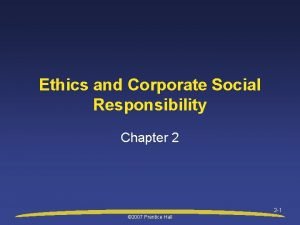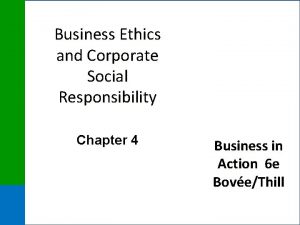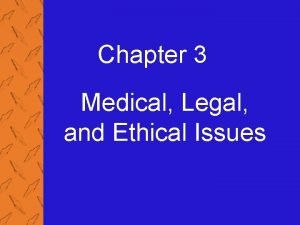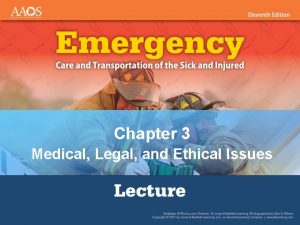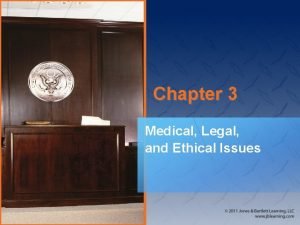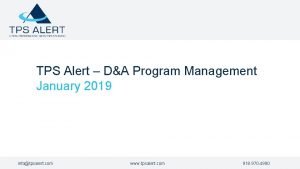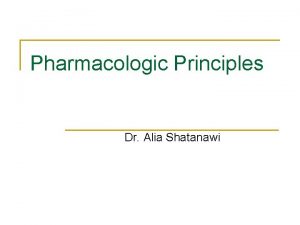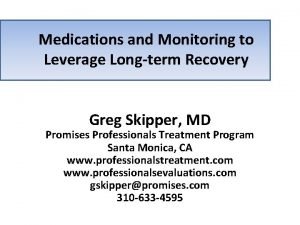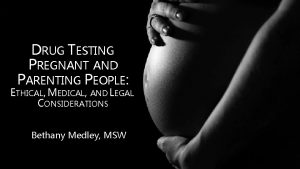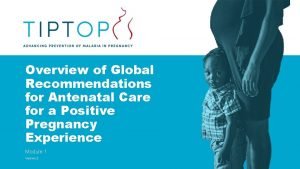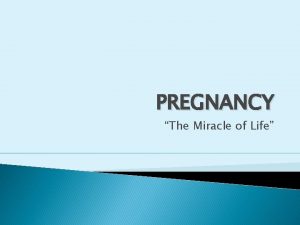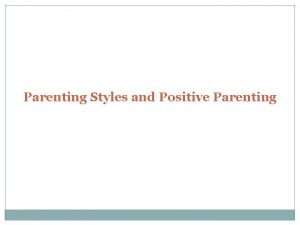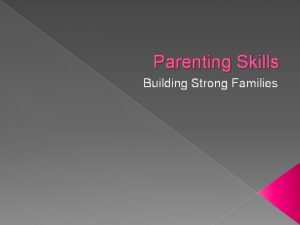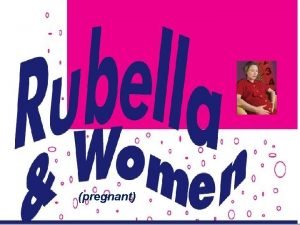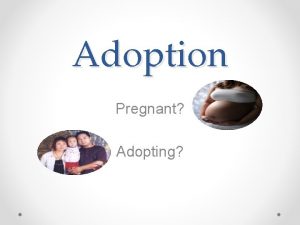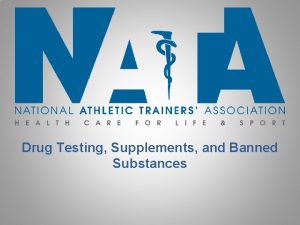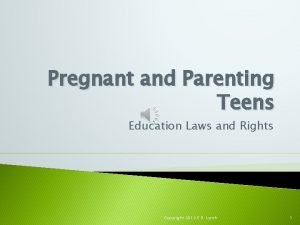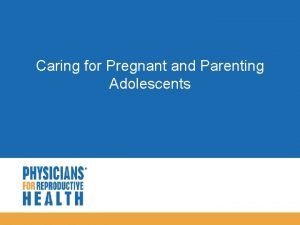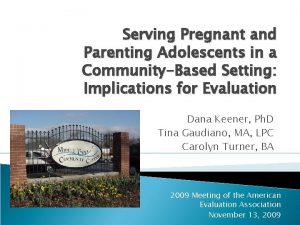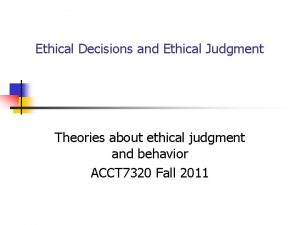DRUG TESTING PREGNANT AND PARENTING PEOPLE ETHICAL MEDICAL




















- Slides: 20

DRUG TESTING PREGNANT AND PARENTING PEOPLE: ETHICAL, MEDICAL, AND LEGAL CONSIDERATIONS Bethany Medley, MSW

Case Study: Jackie At 8 months pregnant, Jackie was receiving buprenorphine treatment for her diagnosed Opioid Use Disorder. Her buprenorphine provider requires urine drug screening at every visit. At the last visit, her drug test indicated a positive result for cocaine. Jackie claimed that it was a false positive and insisted she had not used cocaine. Based on the single drug test result, Jackie was immediately discontinued from her buprenorphine treatment. The following day, at 8 months pregnant Jackie went into labor. “No one believed me that the drug test was a false positive. I was so scared for the health of my baby or even if I was going to be able to keep her. ”

Drug Testing Defined • Drug testing uses a biological sample (i. e. urine, hair, blood) to detect the presence or absence of a specific drug (or drugs) as well as drug metabolites within a specific window of time

Limitations of Urine Drug Testing • Potential for false negative and false positives results (Tenore, 2010) • Not a definitive indicator of substance use disorder • Typically does not test for alcohol or tobacco use • Chain of custody possible mistakes • Increases risk for possible child welfare involvement • Test results do not assess parenting capabilities Tenore, P. L. (2010). Advanced Urine Toxicology Testing. Journal of Addictive Diseases, 29(4), 436448.

Limitations of Urine Drug Testing Continued • Invasive • Often applied selectively (Roberts et al, 2014) • Disproportionately impacts racial and ethnic minorities • Bias towards discretionary “risk” factors (i. e. low income) • Does not measure other perinatal health risk factors • Exposure to violence • Depression Roberts, S. C. , Zahnd, E. , Sufrin, C. , & Armstrong, M. A. (2014). Does adopting a prenatal substance use protocol reduce racial disparities in CPS reporting related to maternal drug use? A California case study. Journal of Perinatology, 35(2).

Notable Court Rulings • Robinson v. California (1962) - Addiction is an illness, and that criminalizing it is a violation of the 8 th Amendment, prohibiting cruel and unusual punishment • Ferguson v. City of Charleston (2001) - Drugtesting pregnant women without their knowledge or consent constituted unlawful search and seizure in violation of the 4 th Amendment • Tennessee's Fetal Assault Law (2014 -2016) Allows women to be charged with aggravated assault (max penalty of 15 years in prison) if they have a pregnancy complication after using illegal drugs

Current State Laws and Policies* • 23 states and DC require health care professionals to report suspected prenatal drug use • 7 states require health professionals to test for prenatal drug exposure for suspected drug use • 24 states and DC consider drug use during pregnancy as child abuse • 3 states consider drug use grounds for civil commitment (forced treatment) or incarceration * Retrieved from Guttmacher Institute, March 1, 2018

45 States have sought prosecution for drug use during pregnancy

Possible Implications of Punitive Measures • No evidence supporting punitive responses decrease drug use in pregnancy (Patrick & Schiff, 2017) • Unnecessary stressful child welfare involvement • Loss of parental rights • Disruption of critical parent/infant bonding time—used as evidence-based treatment of Neonatal Opioid Withdrawal (NOW) • Deters pregnant people from seeking healthcare and social support Patrick, S. W. , & Schiff, D. M. (2017). A Public Health Response to Opioid Use in Pregnancy. Pediatrics, 139(3)

Possible Implications of Punitive Measures • Enforces stigma, discrimination, and imposes blame on the pregnant person • Loss of family and friends support as a result of drug use disclosure • Long-term consequences of being convicted of a drug-related crime • Loss of financial aid • Housing restrictions • Employment challenges • Fails to recognize the inadequacies in the healthcare system and other supportive services for pregnant people who use drugs

Organizations Against the Prosecution & Punishment of Pregnant People • American Medical Association • American College of Obstetrics and Gynecology • American Academy of Pediatrics • American Society of Addiction Medicine • American Public Health Association • American Nurses Association • American Psychiatric Association • National Perinatal Association • March of Dimes • National Advocates for Pregnant Women • American Academy of Family Physicians • Association of Women’s Health • Obstetric and Neonatal Nurses

Treatment Access and Effectiveness • Capacity is inadequate • Only 15% of treatment centers offer specified services (Patrick & Schiff, 2017) • Access is limited • For those in poverty, rural areas, uninsured, or insured through Medicaid • Quality of treatment ranges dramatically • Barriers in treatment for opioid use disorder • Engagement in prenatal care is effective regardless of continued drug use Patrick, S. W. , & Schiff, D. M. (2017). A Public Health Response to Opioid Use in Pregnancy. Pediatrics, 139(3)

Ethical Principles Dignity and Respect Autonomy Nonmaleficence Privacy and Confidentiality Justice Competent Care

Dignity and Respect • Humiliation should never be used as a tool to force change • The research on the association of child abuse and drug use during pregnancy is biased and limited • Model compassion and non-judgment • Necessary to develop a trusting relationship and engage the pregnant person in care

Non-maleficence • Know how test results are being used • Be familiar with state’s reporting laws • Assess treatment options • Consider risks in maintaining engaged and continued care • “No clinical action of consequence should be made on a drug test alone - and any action on a urine drug test can be a potentially devastating consequence for a pregnant woman” - American Society of Addiction Medicine (ASAM) Guidelines

Protect Privacy and Confidentiality • Reporting mandates vary widely, be familiar with the legal requirements within your state • When health care professionals act on behalf of the state • Impacts confidence and trust in the patient-provider relationship and medical community • Results in poor disclosure by patients, reducing the efficacy of diagnosis and treatment • “Social workers should disclose the least amount of confidential information necessary to achieve the desired purpose” - NASW Code of Ethics

Respect Autonomy • Autonomy is violated when providers allow state to intervene • Pregnancy is non-binary (Terplan, 2016) • Maternal-fetal and maternal-infant dyad should be considered as a unit • Mother’s rights and interest cannot be separated from fetus • ‘Two patient’ concept has been used to override a pregnant person’s decision-making authority • All treatment options should be in consensual agreement with the pregnant person Terplan, M. (2017). Beyond the Treatment Box. Journal of Addiction Medicine, 11(3), 176 -177.

Challenge Social Injustice • Acknowledge that punitive measures are not applied evenly across race, gender, or socioeconomic status • Recognize there are no attempts to impose legal sanctions for paternal partners who use drugs • Can universal screening eliminate CPS reporting racial disparities? • No, one study found 5 x more black than white newborns were reported to CPS using universal screening (Roberts et al. 2015) • Include people with lived experiences in the conversation Roberts et al. , (2015). Does adopting a prenatal substance use protocol reduce racial disparities in CPS reporting related to maternal drug use? A California case study. Journal of Perinatology, (35)

Competent Care • Advocate to decriminalize disease and prioritize evidence-based treatment • Treatment should be applied similar to any other chronic illness • Advocate to improve and expand existing treatment options • Continuation of care following delivery • Increased risk for overdose death • Most opioid-related deaths happen postpartum (Koch et al. 2016) Koch, A. R. , Rosenberg, D. , & Geller, S. E. (2016). Higher Risk of Homicide Among Pregnant and Postpartum Females Aged 10– 29 Years in Illinois, 2002– 2011. Obstetrics & Gynecology, 128(3), 440 -446.

What is happening in your community? Challenges and/or best-practice examples
 Ethical decision making and ethical leadership
Ethical decision making and ethical leadership Accidental adulteration definition
Accidental adulteration definition Perbedaan ethical dilemma dan ethical lapse
Perbedaan ethical dilemma dan ethical lapse Army ethical lenses
Army ethical lenses Chapter 4 ethics and social responsibility
Chapter 4 ethics and social responsibility Can period pains be a sign of pregnancy
Can period pains be a sign of pregnancy Chapter 3 medical legal and ethical issues
Chapter 3 medical legal and ethical issues Legal and ethical issues chapter 3
Legal and ethical issues chapter 3 Medical legal and ethical issues chapter 3
Medical legal and ethical issues chapter 3 Tps alert
Tps alert Alia drug testing
Alia drug testing Recoverytrek drug testing option 2
Recoverytrek drug testing option 2 Urine drug testing
Urine drug testing Plan b campaign
Plan b campaign Is elizabeth proctor pregnant
Is elizabeth proctor pregnant 3 weeks pregnant ultrasound
3 weeks pregnant ultrasound Dogmatism fallacy example
Dogmatism fallacy example Baby mosquito fish
Baby mosquito fish đầu ối phồng
đầu ối phồng Prayer point for expectations
Prayer point for expectations Vitagen
Vitagen


